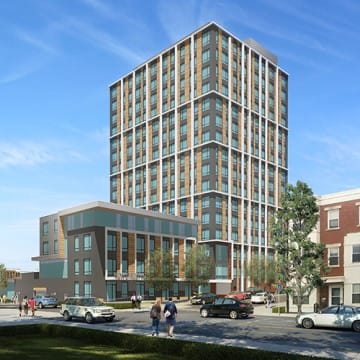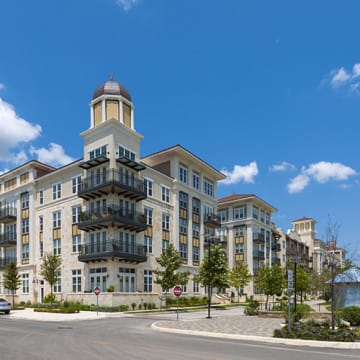Edison Eastlake
The city of Phoenix’s Housing Department is advancing a strategy to redevelop Edison Eastlake as a heat-resilient, affordable neighborhood east of downtown. Supported by a $1.5 million U.S. Department of Housing and Urban Development (HUD) Choice Neighborhood Planning and Action Grant and $193 million from the city, the project will redevelop 557 outdated public housing units into a mixed-income community of more than 1,000 new homes to be heat resilient and more walkable, healthier, and connected. The Edison Eastlake One Vision Plan, led by design firm Mithun and created with residents and stakeholders, lays out the strategy for redevelopment and identifies cooling the urban heat island effect as one of three top implementation priorities.
The three public housing developments (Sidney P. Osborn Homes, A.L. Krohn Homes, and Frank Luke Homes) that make up the Edison Eastlake site were constructed between 1942 and 1963 and suffer from mold, failing systems, and an isolating design.
Further, the neighborhood was subject to redlining in the 1930s and 1950s (preventing people of color from securing financing to buy homes), so current homeownership is low (16 percent in 2019). The area has recently experienced high unemployment and crime rates, and more than 80 percent of local residents have annual incomes less than $11,000, making it one of the poorest areas in central Phoenix.
Temperatures in Edison Eastlake are also among the hottest in Maricopa County. Surface temperature maps from Arizona State University show that Edison Eastlake is on average 105°F during the summer and often 130°F on extreme days. Moreover, unlike other areas in Phoenix, Edison Eastlake has low vehicle ownership, so residents are walking, biking, or taking public transportation and are “out there in the heat all summer long,” says Cindy Stotler, director of the Phoenix Housing Department.
As part of the One Vision Plan, the city, supported by community organizations Local Initiatives Support Corporation–Phoenix and Vitalyst, conducted a two-year community feedback process that began with a detailed Health Impact Assessment survey. “One of the major findings of the Health Impact Assessment was that the urban heat island is significantly impacting the health of residents,” says Stotler.
Residents identified heat-related health concerns, including respiratory and cardiovascular disease, specific heat illness, and lack of ability to walk safely, and supported the idea of “practical resilience through redevelopment.”
Extreme Heat Resilience Strategies
Mithun developed new housing prototypes that seek to mitigate extreme heat by maximizing shade and ventilation and incorporating cool building materials. For example, courtyard housing maximizes shade, and single-loaded apartments with open breezeways on one side and apartments that have operable windows on both sides allow for cross ventilation. Energy efficiency is another priority. “We go for as much energy efficiency as possible,” says Stotler, “because we’re building to own forever, don’t have the money to rehab, and want to save residents on their utility bills.”
We are focused on bringing up the entire neighborhood to higher wealth, health, and education standards. –Cindy Stotler, Director, Phoenix Housing Department
The site plan also maximizes green space while taking an intentional approach to water efficiency. Clusters of drought-tolerant and native plants will provide cool islands, supplemented by strategic lawn areas. Planned public spaces and rights-of-way adhere to Phoenix’s zoning code requirement that all new sidewalks must be 75 percent shaded. Cool paving technologies including experimental coatings and paving materials are being explored for paths and sidewalks.
The One Vision Plan includes emergency preparedness in its heat resilience approach; the planning team debated adding backup water supply and generators to each building but concluded a more doable method would be to include those elements in common facilities. Community meeting places, including a central festival street and cultural corridor, are provided in each block, creating “a logical meeting place for people who can’t get very far to organize and help each other in a disaster,” says Erin Christensen Ishizaki, partner at Mithun.
Outcome
In 2018, Phoenix Housing won—through a very competitive process—an additional $30 million HUD Implementation Grant, the largest ever received in Arizona, using the One Vision Plan in the application. The Implementation Grant covers one-third to one-fifth the cost of the redevelopment; while financing is being finalized, Gorman Partners was selected by the city in July 2018 as the development partner.
Plan implementation in Edison Eastlake is already underway. Phoenix Housing has begun development on one vacant lot, and construction for the first new housing development of 177 units is planned to begin January 2020. The project will be phased in over six years (the length of the Implementation Grant).
Building on the One Vision Plan, Phoenix Housing’s staff are finalizing neighborhood and housing details, especially those factors, such as setbacks and window design, that relate to heat mitigation. Phoenix Housing also continues to coordinate with Arizona State University to track heat in the neighborhood and the success of UHI mitigation measures. Arizona State University researchers have installed multiple weather stations in the neighborhood to measure baseline temperatures and track neighborhood temperature change from construction through buildout.


